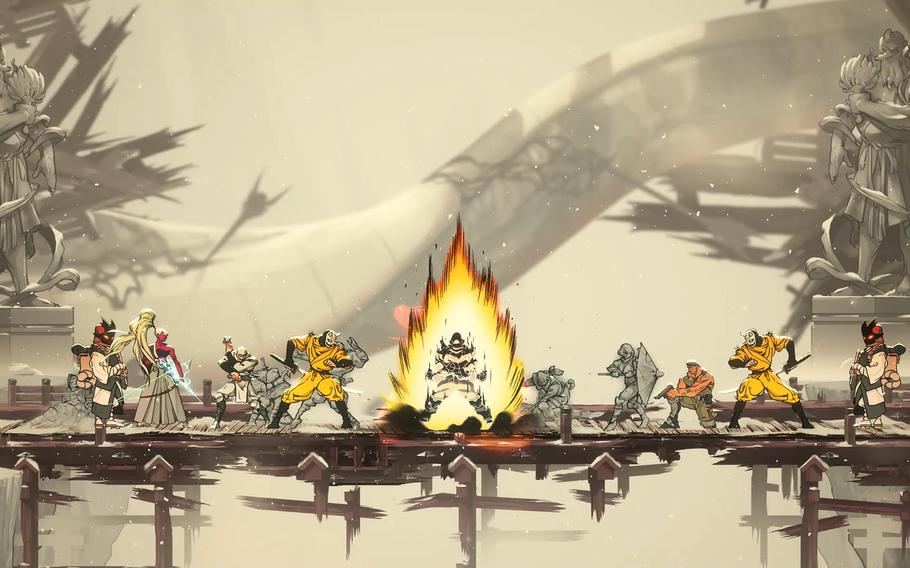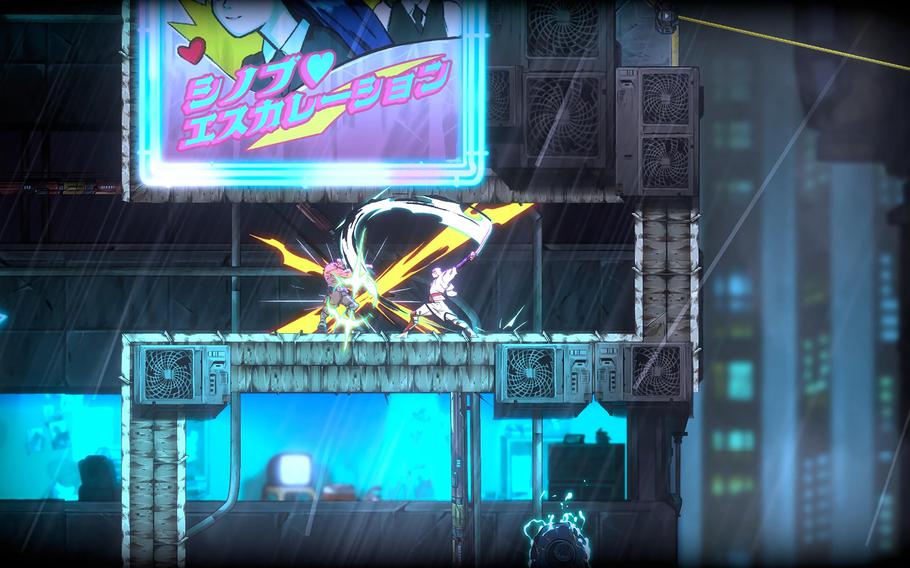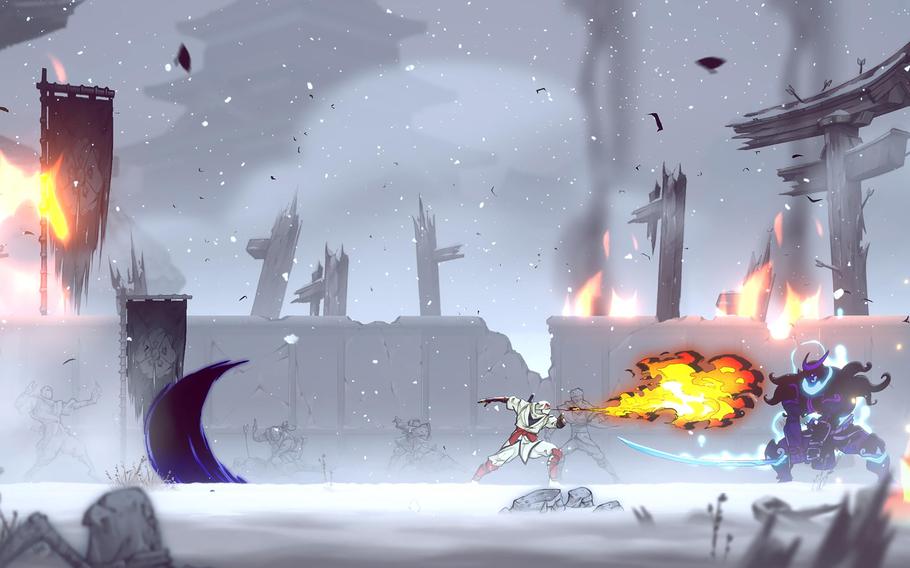
Shinobi: Art of Vengeance is part of Sega’s attempt to revive classic franchises from the 1990s by contracting passionate studios, like Paris-based LizardCube. (Sega)
There’s a myth that true immersion into video games requires three dimensions: sidescrollers are good for nostalgia, but the future belongs to photorealistic 3D worlds.
But a range of recent games like indie darling Hollow Knight are proving millennia-old, 2D hand-drawn art will endure in video games. Ben Fiquet, a Parisian artist who founded game studio Lizardcube, now contracted by Sega in the Japanese firm’s efforts to revive languishing intellectual property from its troves, remains dedicated to the craft. Fiquet is creative director for Sega’s new title Shinobi: Art of Vengeance, scheduled for release Aug. 29 on Nintendo, PlayStation, Xbox and PC platforms.
Fiquet says he created Lizardcube to be a beacon of light for 2D animation in gaming, inspired by award-winning ’90s game developer Dave Perry, who created that era’s visually stunning Earthworm Jim. The studio’s effort is backed up by several critically acclaimed 2D games with Sega’s Streets of Rage 4 and the Wonder Boy series.
“The inherent power of 2D lies in its straightforward simplicity: the artist’s vision brought directly to life,” Fiquet tells The Post. “There are no tricks or deceptions, just pure craft. While it can be challenging to elicit player emotion, I believe 2D can resonate more deeply, strongly and lastingly.”
Sega of America visited The Washington Post newsroom with a PlayStation 5 console and an early copy of Shinobi: Art of Vengeance. The publishers believe the game speaks for itself once in the player’s hands, and they’re correct. The feel of the game requires the mental agility and focus of a fighting game, with a free-flowing combat system that includes juggling combination attacks in the air, counters and follow-up techniques like rolls and dive kicks.
Sega knew Lizardcube was perfect thanks to the studio’s success in translating the arcade brawler Streets of Rage 4 for the 21st century while retaining its crunchy spirit. Kagasei Shimomura, director of Sega’s content production department, is a longtime producer since the company’s golden era of the 1990s. As part of the now defunct Sega Ages project, which brought classic titles to modern platforms, he’s been a key figure in keeping Sega franchises alive after the turn of the century, when Sega famously exited the video game console business in 2001 to become a publisher and developer for other platforms.

Modern and ancient Japan fuses together in the background of Shinobi: Art of Vengeance, a 2025 reimagination of Sega’s arcade classic series. (Sega)
The company is most famous for creating Sonic the Hedgehog, but in recent years, its found success in role-playing games focused on Japanese culture with the Like a Dragon series, focused on yakuza life, while the multimillion selling Persona series features young adult fantasy adventures. This success gave Sega newfound confidence in reviving classic franchises from its golden era.
“When launching the Ages project, our first task was to select a series to bring back, and the one that always came to mind was Shinobi,” Shimomura said. In 2023, Sega announced a full-court press of franchise revivals across the company, and Shimomura once again made reviving Shinobi his priority.
“And when it came to bringing that title to life, only one name came to mind: Lizardcube,” he continued. “I contacted them right away and was surprised to learn that they were also very passionate about the Shinobi series and had hoped to work on a game someday. That settled it for me. Lizardcube was a must-have developer for the new Shinobi title.”
The company has tried a dozen times to revive the Shinobi series, including an ambitious dalliance into 3D gaming with a 2003 PlayStation 2 title that was well received but saw limited success. Lizardcube’s entry will be the first Shinobi game in 14 years, and its return to the two-dimensional plane is deliberate.
“Sega’s revival project is guided by the principle of lore meeting innovation,” Shimomura said. “This means we don’t simply enhance the visuals of past titles, instead we break down the original works to their very core, redefine their inherent appeal and combine them with new elements that will excite today’s players.”

Shinobi: Art of Vengeance is inspired by Japanese black-ink brushstroke paintings to breathe new life into the action arcade series. (Sega)
One of the consistent features passed down from Shinobi’s arcade lineage is punishing difficulty. But in a welcome move for anyone hoping for a more relaxing time, Lizardcube’s game provides multiple options to make the experience easier, including making the player’s iconic white-clad ninja protagonist Joe Musashi hit harder while taking more damage.
The game features stunning layered backgrounds depicting futuristic mash-ups of Japanese traditional and urban environments, including busy cityscapes dotted with digital and street artwork. A robust skill tree can be filled out with many collectibles found through battles and exploration within a surprisingly nonlinear level design that pushes players against every axis of the map. It also includes arcade-like challenges for a more focused experience on platforming and action without any narrative beats.
The animation is exceptionally fluid, highlighted by lovely black ink brushstrokes of traditional Japanese paintings. Creating evocative and immersive images with 2D hand-drawn art is a different kind of challenge from 3D games, Fiquet said.
“While not overly complex, it demands skilled artists and a pipeline capable of handling it,” he said. “Most modern hardware is optimized for rendering intricate 3D assets, but managing thousands of stacked images presents a different challenge.” In many ways 2D renderings are less flexible, he said, “requiring all decisions to be made well in advance.”
Shinobi: Art of Vengeance is shaping up to be a vanguard title for Sega’s efforts to galvanize its arcade roots. More broadly, and considering Lizardcube’s pedigree and passion, it’ll be another brushstroke in 2D art’s durability even in the fast-evolving medium of video games.
Platforms: PC, Nintendo Switch, Playstation 4/5, Xbox One, Xbox X/S